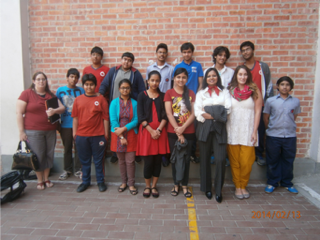In the coming weeks, thousands of college students will walk across a stage and proudly accept their diplomas. Many of them will be hungry.
A senior at Lehman College in the Bronx dreams of starting her day with breakfast. An undergraduate at New York University said he has been so delirious from hunger, he’s caught himself walking down the street not realising where he’s going. A health sciences student at Stony Brook University on Long Island describes “poverty naps,” where she decides to go to sleep rather than deal with her hunger pangs.
These are all examples of food insecurity, the state of having limited or uncertain access to food. Stories about college hunger have been largely anecdotal, cemented by ramen and macaroni and cheese jokes. But recent data indicate the problem is more serious and widespread, affecting almost half of the student population at community and public colleges.
A survey released this week by Temple University’s Hope Center for College, Community and Justice indicated that 45 percent of student respondents from over 100 institutions said they had been food insecure in the past 30 days. In New York, the nonprofit found that among City University of New York or CUNY students, 48 percent had been food insecure in the past 30 days.
Kassandra Montes, a senior at Lehman College, is one of them. She unexpectedly had to take out a $5,000 loan this year in order to graduate, she said. Living in a Harlem homeless shelter as she attends classes, Ms Montes also works two part-time jobs and budgets only $15 per week for food. She uses the campus food pantry to get most of her groceries and usually skips breakfast in order to make sure that her 4-year-old son is eating regularly.
“I feel like I’m slowly sinking as I’m trying to grow,” she said.
Although the college food-pantry movement is well underway, as there are now over 700 members at the College and University Food Bank Alliance, efforts have recently expanded to include redistributing leftover food from dining halls and catered events, making students eligible for food stamps and other benefits, and perhaps most important, changing national and state education funding to cover living expenses, not just tuition.
“The hunger movement has been centred around food banks, but that is now changing as people focus on prevention,” said Sara Goldrick-Rab, the founder of the Hope Centre and a Temple University professor.
The movement has largely focused on community and state colleges, as there are more low-income students who attend them. Hunger can force students to drop out of school to work more, which inhibits academic success, said Nicholas Freudenberg, a distinguished professor at CUNY’s Graduate School of Public Health and Health Policy. Another ramification is an increase in student loans to cover living expenses, Dr Goldrick-Rab said. (National student debt now totals about $1.5 trillion.)
Calvin Ramsay amassed “massive amounts of debt” while attending NYU Being the first person from his family to go to college, he said he didn’t fully understand how much debt he was going into with his student loans. After two years on campus, Mr Ramsay said he moved back home to Queens and started to use Share Meals, a digital platform created in 2013 that informs students about free food on campus.
“Food was a major obstacle,” he said, “especially in Manhattan.”
Mr Ramsay said that he will need to borrow about $40,000 more to graduate, but he is unwilling to take on more debt to do so. “Why do I need to go into debt,” he said, “to eat?”
CUNY has discovered that signing up students for SNAP, or the Supplemental Nutrition Assistance Program, has helped. In 2009, the school system brought in Single Stop USA, a nonprofit that connects individuals with social services. Since then, the nonprofit and other partners have served over 122,000 CUNY students, each of whom have received about $3,000 worth of benefits each year, said Sarah Crawford, the nonprofit’s national education director.
Many states, including New York, have work requirements to get SNAP, but such a requirement should be waived if the recipient is a student, Ms Crawford argued. In addition, many advocates say that SNAP benefits should be redeemable at dining halls and stores on campus.
Niasia Starling, a 22-year-old student at Nassau Community College, part of the State University of New York system, recently had her SNAP benefits terminated because she stopped working to take care of an ill parent.
Ms Starling, who has been sleeping at a friend’s house because she has no home, said that she finds comfort at the NEST (Nassau Empowerment and Support for Tomorrow), the campus food pantry. Besides getting necessary supplies, she has found a support group there.
“I know I am not less than other people because I don’t have as much,” the upbeat Ms Starling said. “But it’s hard to be hungry and motivated.”
Niasia Starling, a student at Nassau Community College, recently had her SNAP benefits terminated because she stopped working to take care of an ill parent.
Since it opened in November 2015, the NEST has buzzed with life. On a recent weekday morning, dozens of students grabbed multiple shopping bags of food, which also helps feed their families, said Sharon Masrour, one of the project’s organisers. The pantry is now a model for other SUNY and CUNY pantries and is part of Gov Andrew M Cuomo’s Food Insecurity Task Force. It is also now a stop on freshman orientation tours.
“The role of a campus food pantry has gone beyond just providing food,” Ms Masrour said. It’s a chance for the school to check in on a student’s life outside of campus because the tiers of issues, like health and housing, all contribute to food insecurity. “It’s now a basic-needs hub.”
It was at a pantry at SUNY Stony Brook where Jocelyn Chen, a volunteer there, spoke of her poverty naps. She said that many students are unable to visit the food pantry between classes, or to go off campus to find cheap food without a car.
“When you’re in class for, like, three hours, it’s hard to concentrate when you’re hungry,” she said. Back at the dorm, she explained, it’s easier to take “poverty naps” than to forage for something to eat.
The Debt-Free College Act, which aims to cover all costs associated with attending a public college, was reintroduced this year. Advocates are also hoping Congress expands the National School Lunch Program to higher education.
Boosting federal education funding should be part of the presidential election discussion, said Dr Goldrick-Rab, who cited a higher education plan put out by Senator Elizabeth Warren of Massachusetts, a Democrat who is running for president.
If no progress is made, Dr Goldrick-Rab said, “Existing investments in financial aid will be undermined as students drop out simply because they don’t have enough to eat.”






















